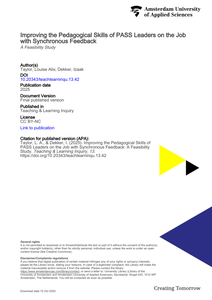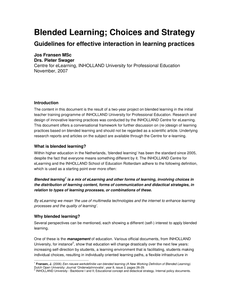As multimedia gradually becomes more and more an integrated part of video conferencing systems, the use of multimedia integrated desktop video conferencing technology (MIDVCT) will open up new educational possibilities for synchronous learning. However, the possibilities and limitations of this technology must be clearly understood so that it can be used to maximize possible pedagogical benefits and reduce possible pedagogical limitations. This paper analyses the process of integrating MIDVCT in a first-year English language course, and offers insights into theoretical underpinnings of multimedia learning from two perspectives: the generative theory of multimedia learning and the cognitive overload theory. The data discussed in this paper have been drawn from a study which took place in a cross institutional setting at Fontys University of Applied Sciences, The Netherlands. The data were collected and analyzed according to a qualitative approach.
DOCUMENT

Several bachelor courses of Inholland University of Applied Sciences experimented with the possibilities of the online synchronous classroom. Two platforms were used; Zoom video conferencing and Barco Virtual Classroom. As research group, we conducted exploratory observations as this experimentation unfolded during several of these sessions. Interviews were held with some teaching and technical staff. Organisational, technical and pedagogical factors regarding the delivering of flexible education were examined. During the observations of this emergent practice, some patterns became visible. This report contains a first description of the seven phases when initiating the online classroom.
DOCUMENT

Effective and quality online education requires an instructional design approach that can lead to educational transformation. This approach can be characterized by advanced flexibility, learner autonomy and extensive use of digital technologies to enhance learning outcomes. One of the main challenges of online education, which has been investigated by current researchers in the field, is the physical distance between educators and learners. In this context, synchronous communication, perceived as the direct communication that occurs in real time between learners and educators, has been considered as a way to bridge this distance and improve communication and interaction in teaching and learning.As the field of synchronous communication in online education is ever maturing, this paper attempts to systematically review the literature relevant to technological tools and strategies, which can lead to a productive student experience. The two authors collaborate to apply a qualitative method, coding and synthesizing the results using multiple criteria. The main objective of this systematic literature review is to identify the tools, theories and strategies that online education providers can implement to ensure that synchronous instruction enhances students’ learning outcomes. The research, which was conducted between January and April 2020, used Google Scholar and ProQuest data bases. The reviewed papers were selected with prior chosen keywords: synchronous communication, technological tools for synchronous communication, effective synchronous communication, synchronous communication learning experiences, strategies for synchronous communication, theories for synchronous communication, software for synchronous communication. The term interaction was also used instead of the term communication in the combination of keywords mentioned above. The keywords were combined while operating the Boolean operator “AND”. The selected papers were published in peer-reviewed journals, in English, between 2010 and 2020. The selection process consisted of four phases: Identification round, first round of exclusion, second round of exclusion, and final inclusion round. The identified articles were collected in a shared RefWorks project.On balance, results are divided in two main groups:a) technological tools, which enhance synchronous communication,b) learning theories and strategies, which can contribute to an effective synchronous communication experience.As a final step, the authors consolidate evidence for the benefit of academics and practitioners in online education interested in the efficient use of synchronous communication for pedagogical purposes. Such evidence also provides potential options and pathways for future research.
DOCUMENT
Seven college lecturers and two senior support staff were interviewed during 2021 about their experiences teaching in hybrid virtual classrooms (HVC). These technology-rich learning environments allow teachers to simultaneously teach students who are in class (on campus) and students who are joining remotely (online). There were two reasons for this choice: first, ongoing experimentation from innovative teaching staff who were already using this format before the COVID-19 pandemic; secondly, as a possible solution to restrictions on classroom size imposed by the pandemic. Challenges lecturers faced include adjusting teaching practice and lesson delivery to serve students in the class and those online equally; engaging and linking the different student groups in structured and natural interactions; overcoming technical challenges regarding audio and visual equipment; suitably configuring teaching spaces and having sufficient pedagogical and technical support to manage this complex process. A set of practical suggestions is provided. Lecturers should make reasoned choices when teaching in this format since it requires continued experimentation and practice to enhance the teaching and learning opportunities. When external factors such as classroom size restrictions are the driving force, the specific type of synchronous learning activities should be carefully considered. The structure and approach to lessons needs to be rethought to optimise the affordances of the hybrid virtual and connected classroom. The complexity of using these formats, and the additional time needed to do it properly, should not be underestimated. These findings are consistent with previous literature on this subject. An ongoing dialogue with faculty, support staff and especially students should be an integral part of any further implementation in this format.
DOCUMENT

Peer assisted study sessions (PASS), also known as Supplemental instruction, are structured peer guided sessions linked to a specific course, led by experienced and trained students called PASS-leaders. These PASS-leaders undergo several days of training before running their first session and receive supervision and feedback ‘on the job’. Research suggests that training improves student outcomes whereby supervision is considered best practice, as required by PASS protocols. However, it is unclear what type of supervision best supports PASS-leaders. Thus far, studies have not compared different methods for on-the-job interventions. Current practice involves supervisors observing PASS sessions without intervening but providing post hoc feedback. While this prevents undermining the PASS leaders, it delays their ability to act on feedback immediately. This study, carried out at an institution for initial teacher education, developed and tested a method for providing immediate feedback using a bug-in-ear device linked to a live-stream. Six PASS-leaders were observed during 4-6 sessions each, receiving either synchronous feedback with a bug-in-ear or in-person asynchronous post hoc feedback. In group interviews PASS-leaders reported appreciating the immediacy of synchronous feedback which allowed them to act on it in real-time. The surveys after each lesson indicated that they felt significantly more confident about teaching following live feedback. They described the supervisor as an invisible helper, providing support or assistance. Because the bug-in-ear method could only provide feedback on visible instructional and pedagogical actions, both PASS-leaders and PASS-supervisors recommended using this as a supplement to a pre-session briefing and a post-session debrief.
DOCUMENT

The content in this document is the result of a two-year project on blended learning in the initial teacher training programme of INHOLLAND University for Professional Education. Research and design of innovative learning practices was conducted by the INHOLLAND Centre for eLearning. This document offers a conversational framework for further discussion on (re-)design of learning practices based on blended learning and should not be regarded as a scientific article. Underlying research reports and articles on the subject are available through the Centre for e-learning.
DOCUMENT

De implementatie van blended learning – waarbij fysiek leren wordt gecombineerd met online leren – staat bij veel onderwijsinstellingen hoog op de agenda, om activeren, intensiveren, flexibiliseren, differentiëren en/of personaliseren mogelijk te maken (Bos, 2022). Als gevolg hiervan krijgt de online leeromgeving binnen onderwijsinstellingen een steeds nadrukkelijkere rol. Om te komen tot betekenisvol leren in deze online leeromgeving (vaak in de vorm van een leermanagementsysteem, ook wel LMS genoemd), is het belangrijk dat studenten hierin actief aan de slag gaan met de aangeboden onderwijsinhoud en geïnteresseerd en gemotiveerd zijn om dit te (gaan) doen (Michael, 2006; Alhazmi & Rahman, 2012; Derboven et al., 2017; Grant-Smith et al., 2019). Echter, in de praktijk blijkt dat lang niet altijd sprake is van deze gewenste student engagement. Bijlage 1: Dit artikel geeft de resultaten weer van een onderzoek naar mogelijkheden om student engagement in het LMS te vergroten. Deze resultaten zijn tevens samengevat in twee overzichtelijke infographics. Bijlage 2: Infographic 1 omvat het gehele overzicht van de (mogelijk) te implementeren ontwerpprincipes. Bijlage 3: Infographic 2 bevat een stappenplan voor docenten om hun LMS te analyseren en te optimaliseren (laaghangend fruit).
MULTIFILE

This is a tool that you can use when designing and delivering (online) active learning. The tool will help you find answers to questions such as: − Which learning activities can I offer students in order to achieve a specific learning objective? − Is there an optimum order for learning activities? − How do I ensure that students become actively involved in their own learning process?
DOCUMENT

The purpose of the present case control study was to assess parental satisfaction with speech and facial appearance in Ugandan children with complete unilateral or bilateral cleft lip and palate (CLP), who underwent a synchronous lip and palatal closure. The results are compared with an age- and gender-matched control group. The experimental group consisted of the parents or guardians of 44 Ugandan patients (21 males, 23 females) with complete unilateral or bilateral CLP (mean age: 3;1 years). The control group included the foster mothers of 44 orphan children matched by age and gender (mean age: 3;7 years). A survey based on the Cleft Evaluation Profile was used to assess the perceived satisfaction for individual features related to cleft care. Overall high levels of satisfaction were observed in the experimental group for all features (range: 56-100%). No significant differences could be established regarding age, gender, age of lip and palatal closure, cleft type or maternal vs. paternal judgments. In participants who were dissatisfied with the appearance of the lip, the time period between the cleft closure and the survey was significantly larger compared with satisfied participants. Furthermore, significantly lower levels of satisfaction were observed in the cleft group for speech and the appearance of the teeth and the nose compared with the control group. Satisfaction with speech and facial appearance in Ugandan children with cleft lip and/or palate is important since normal esthetics and speech predominantly determine the children's social acceptance in the Ugandan society. LEARNING OUTCOMES: As a result of reading this manuscript, the reader will be able to explain the attitudes of parents toward the surgical repair of their children's cleft lip and palate. As a result of reading this manuscript, the reader will be able to identify differences in parental attitudes toward synchronous lip and palate repair.
DOCUMENT
Collaborative Online International Learning (COIL) is often framed as an example of a broader practice known as Virtual Exchange (VE). The term Virtual Exchange has increasingly been used as an attempt to unify a fragmented field of Higher Education practice and is often used interchangeably with the term COIL. However, the design of COIL, with its strong focus on collaborative and intercultural learning, is often very different to other VE initiatives. Labelling all VE initiatives, including COIL, generally as VE, can lead to both educators and researchers having difficulty identifying and distinguishing COIL. Therefore, the purpose of this paper is to provide a critical review of VE and define COIL and its key characteristics. This article also describes how theory can inform practice and explains why continued interchangeable use of the term COIL with the umbrella term Virtual Exchange is unhelpful for future research and practice.
DOCUMENT
